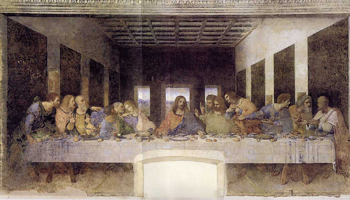| Search Art Prints | ||||||||||||||||||||
| Search Artists | ||||||||||||||||||||

|
||||||||||||||||||||
|
|
|||||||||||||||||||

The Last Supper

|
Leonardo is certainly one of the most famous painters of all time. With this in mind, it is astonishing to think that he produced so few paintings, little more than a dozen. Although all are of course beautiful, The Last Supper, is a Masterpiece and became famous almost immediately after it was completed.
The Last Supper was painted as a mural on the wall of the Grazie in Milan. Unfortunately, because Leonardo was experimenting with an oil-tempura medium of paint that did not adhere well to the wall the fresco began to deteriorate very quickly, within a few years of it first being painted.
One of the reasons that this painting is so famous is the balance achieved in it. The figures in it though biblical, are rendered from the faces that Leonardo saw around him as he wanted to make the painting as realistic as possible in terms of expressions. When observing the painting one feels like these figures come to life and are like real people as opposed to historical representations of people. This is because Leonardo has managed to do what he wanted to in terms of making the expressions on the faces of the men realistic. There was even a rumor circulating that the model for Judas (the betrayer of Christ) was the prior (head priest) of the Grazie! It would have been a big insult to a prior to be portrayed as Judas.
The painting is beautiful; of this there is little doubt. We see Christ with a beautiful expression on his face of sorrow and understanding, sitting with His head bowed and His hand open on the table. He already knows and has accepted that one of His own will betray Him. There is Judas, the one who betrays him, at the end of the table. Unlike all the other disciples, Judas speaks and is spoken to by no one. The moment captured in the painting seems to be the moment right after Jesus says that He knows He will be betrayed by one of His own. The other disciples are all discussing who this could be; devastated that it is one of them. Only Judas remains silent.











